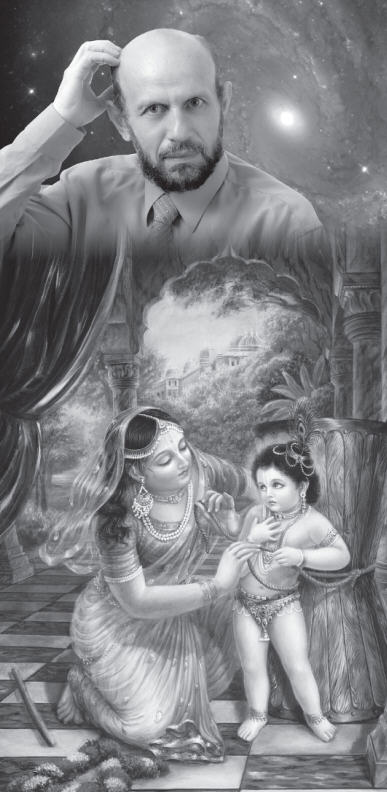Lord Krsnas Damodara pastime teaches us that our great intellects will take us only so far.

THIS ISSUE of Back to Godhead comes out during the month of Damodara(October 27-November 24), associated with the Damodara lila, the pastime in which Krsna's mother, Yasoda, tried to tie Him up with a rope. The rope turned out to be two fingers short. She added rope, but no matter how many ropes she tied together, the combined rope remained two fingers short.
This pastime signifies that no matter how much we try, we will always fall short in our attempts to unde rstand God with our intelligence alone. Science is finding the same about the universe, which the Vedic literature says is a product of God's super intelligence. Centuries of cosmological research have increased scientific information but not sc ientific understanding, be· cause of "two" unexpected shortcomings:
1. The more scientists know, the more they realize how little they know. Scientists "conquered" space and realized how little they actually knew about it.To the uninformed, space missions proved human greatness. To the well informed, they showed human smallness. Space research reveals that the universe contains more celestial bodies than all the grains of sand on all the beaches of the world and our earth is just one of these cosmic grains. No wonder Kenneth R. Boulding, former president of the American Association for the Advancement of Science, admitted, "Cosmology … is likely to be very insecure because it studies a very large universe with a small and biased sample."
2. The more scientists know, the more they realize that what they previously "knew" was wrong. Newton's laws were considered bedrock truths of physics till they were found inapplicable in the microscopic and the macroscopic realms. Quantum physics was developed to explain the atomic world, and relativistic physics for the cosmic. But they turned out to be violently contradictory. As both have to coexist at the origin of the universewhen the microscopic and the macroscopic were one-scientists had the formidable challenge of devising a Theory of Everything (ToE) to unify these irreconcilable pillars of science.
Let's review the history of the development of the ToE:
1. Initial vain roar. Physicist Leon Lederman: "We hope to explain the entire universe in a single, simple formula that you can wear on your T-shirt."
2. Subsequent exasperated grunt. Astrophysicist Steven Weinberg: "As we make progress understanding the expanding universe, the problem itself expands, so that the solution always seems to recede from us."
3. Final concealed whimper. Theoretical physicist John Wheeler: "Never run after a bus or woman or cosmological theory, because there'll always be another one in a few minutes."
SCIENCE NEEDS GRACE
Going back to the pastime, the rope mother Yasoda was trying to tie around Krsna was only two fingers shorr. But the rope of ToE that science has been trying to tie around the universe is not only short but also broken, as Stephen Hawking confessed: "The theories [in physics] we have so far are both inconsistent and incomplete."
Mother Yasoda did eventually succeed in tying Krsna, but only when Krsna, by His own grace, let Himself be bound. Similarly, science can understand the universe, especially our place and purpose within it, but only when it harmonizes with Super Intelligence by researching and applying the verifiable spiritual science delineated in the Bhagavad-gita, thus paving the way for spiritual revelation. That's not as unscientific as it may sound. A scientist no lesser than the founder of quantum physics, Noble Laureate Max Planck, stated, "For religion, God is at the beginning; for science, God is at the end." And science has starred reaching that end by its discovery of "fine tuning" of the universe: micro-precise adjustment of the values and interrelationships of at least eighty parameters essential for life. Obviously fine-tuning needs a fine-tuner. Of course, diehard devotees of atheism have proposed chance and multiple-universes, but these theories are all intrinsically unproven and unprovable. They fit berrer in the realm of science fiction than science.
When scientists accept the verdict of their own evidence, they will remove the obstacle in a longoverdue spiritual leap of science. Lest they hesitate or falter in this bold step, renowned physicist Michael Faraday's reminder can urge them on: "We ought to value the privilege of knowing God's truth far beyond anything we can have in this world."
Caitanya Carana Dasa is a disciple of His Holiness Radhanatha Swami. He holds a degree in electronics and telecommunications engineering and serves full-time at ISKCON Pune. His free cyber magazine, The Spiritual Scientist, gives a scientific presentation of Krsna consciousness. To subscribe, write to iyfpune@vsnl.com.
